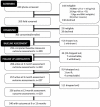Weight Loss through Lifestyle Intervention Improves Mobility in Older Adults
- PMID: 33822933
- PMCID: PMC9653001
- DOI: 10.1093/geront/gnab048
Weight Loss through Lifestyle Intervention Improves Mobility in Older Adults
Abstract
Background and objectives: The high prevalence of overweight or obesity in older adults is a public health concern because obesity affects health, including the risk of mobility disability.
Research design and methods: The Mobility and Vitality Lifestyle Program, delivered by community health workers (CHWs), enrolled 303 community-dwelling adults to assess the impact of a 32-session behavioral weight management intervention. Participants completed the program at 26 sites led by 22 CHWs. Participation was limited to people aged 60-75 who had a body mass index (BMI) of 27-45 kg/m2. The primary outcome was the performance on the Short Physical Performance Battery (SPPB) over 12 months.
Results: Participants were aged 67.7 (SD 4.1) and mostly female (87%); 22.7% were racial minorities. The mean (SD) BMI at baseline was 34.7 (4.7). Participants attended a median of 24 of 32 sessions; 240 (80.3%) completed the 9- or 13-month outcome assessment. Median weight loss in the sample was 5% of baseline body weight. SPPB total scores improved by +0.31 units (p < .006), gait speed by +0.04 m/s (p < .0001), and time to complete chair stands by -0.95 s (p < .0001). Weight loss of at least 5% was associated with a gain of +0.73 in SPPB scores. Increases in activity (by self-report or device) were not independently associated with SPPB outcomes but did reduce the effect of weight loss.
Discussion and implications: Promoting weight management in a community group setting may be an effective strategy for reducing the risk of disability in older adults.
Keywords: Community health workers; Lifestyle intervention; Lower extremity strength; Physical activity; Weight management.
© The Author(s) 2021. Published by Oxford University Press on behalf of The Gerontological Society of America. All rights reserved. For permissions, please e-mail: journals.permissions@oup.com.
Figures
References
-
- Bennett, G. G., Foley, P., Levine, E., Whiteley, J., Askew, S., Steinberg, D. M., Batch, B., Greaney, M. L., Miranda, H., Wroth, T. H., Holder, M. G., Emmons, K. M., & Puleo, E. (2013). Behavioral treatment for weight gain prevention among black women in primary care practice: A randomized clinical trial. JAMA Internal Medicine, 173(19), 1770–1777. doi: 10.1001/jamainternmed.2013.9263 - DOI - PMC - PubMed
-
- Brach, J. S., Perera, S., Gilmore, S., VanSwearingen, J. M., Brodine, D., Nadkarni, N. K., & Ricci, E. (2017). Effectiveness of a timing and coordination group exercise program to improve mobility in community-dwelling older adults. JAMA Internal Medicine, 177(10), 1437–1444. doi: 10.1001/jamainternmed.2017.3609 - DOI - PMC - PubMed
-
- Burd, C., Gruss, S., Albright, A., Zina, A., Schumacher, P., & Alley, D. (2020). Translating knowledge into action to prevent type 2 diabetes: Medicare expansion of the national diabetes prevention program lifestyle intervention. The Milbank Quarterly, 98(1), 172–196. doi: 10.1111/1468-0009.12443 - DOI - PMC - PubMed
Publication types
MeSH terms
Grants and funding
LinkOut - more resources
Full Text Sources
Other Literature Sources
Medical



